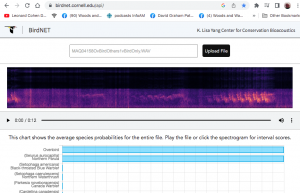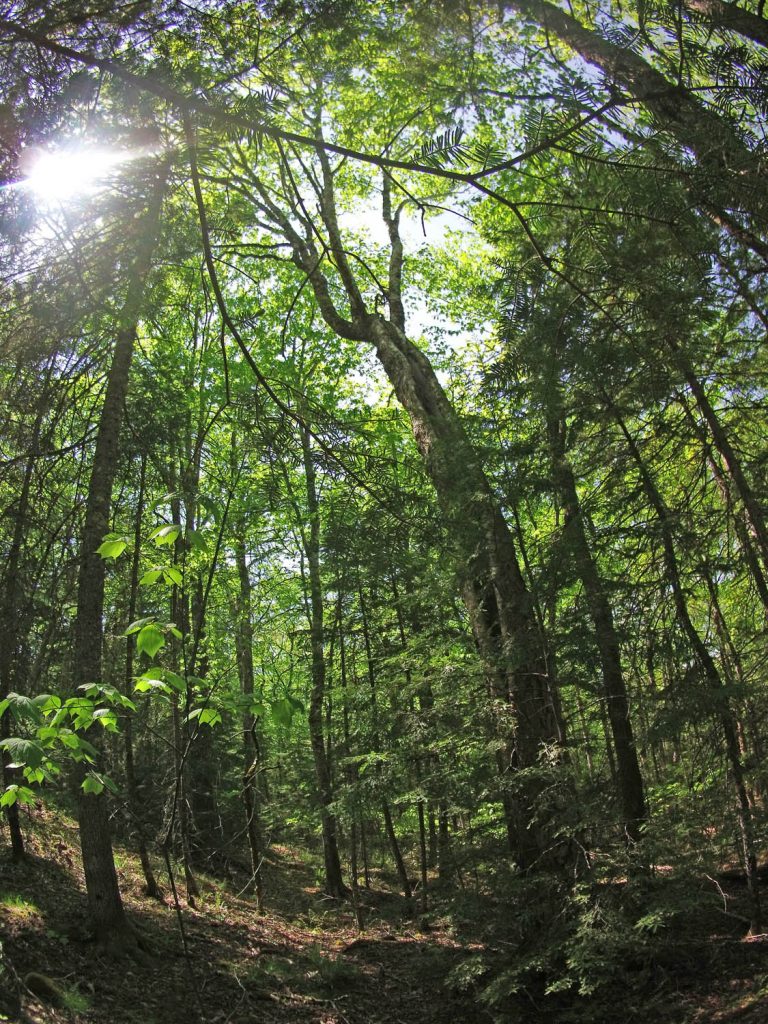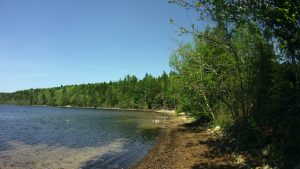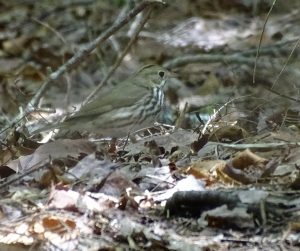At times, it is completely silent by the water and in the forest by Sandy Lake, but not on May 30, 2023.
When I took my usual walking route by the lake and into the forest there were two prominent voices that I had learned to recognize from past walks by Sandy Lake in “mid- to late-spring”*.
________
*The phases of spring: Early – April, Mid – May, Late – the first half of June, From Spring Wildflowers
At Sandy Lake Beach Park, there was the intense trill of male Eastern American Toads. When I approached the marshy edge of the lake, it stopped, and didn’t start again for quite a while.
Later I could hear the trill even way up on a drumlin rising up from the lake.
The first time I heard the toads at Sandy Lake was on May 27, 2018, recorded below.
” By closing their nostrils and mouth, and pumping air over their vocal cords, these amphibians produce a very long trill – up to 35 seconds, which is quite long for any toad or frog call. You can hear toads trilling from quite a distance away thanks to their vocal pouches which are inflated in order to act as resonating chambers.” – From American Toads Trilling with Mary Holland
As I made my way to the magnificent old Wabanaki (Acadian) forest on drumlins by Sandy Lake, I wondered ‘will the Ovenbird be back yet?’ Once I was a fair way into the second drumlin proceeding north from Sandy Lake Beach Park, I got my answer – “Teacher-Teacher-Teacher “.
There was only one bird singing, but on occasion in the past at Sandy Lake, I have heard a virtual chorus of Ovenbirds as described below:
“One male singing loudly to declare its territory can set off a whole chain of responses from his neighbours until the whole forest rings” (From Birds of Eastern Canada) by David M Bird, DK Canada 2019)
I have spotted an Ovenbird just once, that in the photo at right; it was taken on the same day I made the recording of the toads in 2018. The ovenbird was on the ground, probably building a nest:
The female Ovenbird builds a nest in thick leaf litter on the open forest floor at least 60 or 70 feet from the forest edge. She chooses a spot under or near a small break in the canopy, often near where a tree has fallen or near regrowth from some other disturbance…The female clears a circular spot in forest floor litter and over the next 5 days weaves a domed nest of dead leaves, grasses, stems, bark, and hair. …Its resemblance to an outdoor bread oven with a side opening gives the Ovenbird its name.” -from All About Birds

BirdNet identified both Ovenbird and Northern Parula in this short recording (I had expected only Ovenbird.) When you play the recording on BirdNet, it identifies birds singing at different times on the recording.
Another song I recognized on May 30, 2023 was that of a Red-eyed Vireo; and two that I identified with the help of Cornell University’s BirdNet: the Northern Parula and the Black-throated Green Warbler. (I am far from a skilled birder, and find that app incredibly helpful).*
*Load this file into BirdNet to see how it distinguishes OverBird and Northern Parula at different times: MAQ04158OvBirdOthers
But it was the Eastern American Toad on the marshy shore of Sandy Lake and the Ovenbirds in the Wbanaki forest that spoke the loudest on that glorious spring day at Sandy Lake.

Mixed, multiaged, old, Wabanaki (Acadian) forest on the eastern flank of a drumlin by Sandy Lake, May 30, 2023
ABOUT TOADS AND OVENBIRDS
Eastern American Toad
NS Museum of Natural History. “American Toads have flexible habitat requirements. They can be seen in all types of forested areas. Breeding habitats require either permanent or temporary water bodies, including wetlands, swamps, sheltered bays and small streams. Hibernation happens under the frost line. Burrows are dug in mammal dens, in crevices and underground cavities…American Toads emerge from hibernation in the spring and are often the last amphibians to hibernate in the fall. They are active between April and October. Breeding happens over a one-to-two-week period between April and June. A process called amplexus is used…”
American Toad
FrogWatch. “The call is a monotone trill up to 30 seconds long, preceded by a single, slightly lower introductory note. In a breeding chorus each male selects a different note to call on…The American Toad is the only toad in most of eastern Canada.”
Eastern American Toad
Virginia Herpetological Society. Description of the toad, its habit and habitats, ecology referencing scientific literature
Ovenbirds
Cornell All About Birds. Comprehensive with many details, recordings. “Ovenbirds breed in large, mature broadleaf or mixed forests from the Mid-Atlantic states to northeastern British Columbia. They set up summer territories where the leaf canopy overhead inhibits underbrush and provides deep leaf litter hosting plenty of invertebrates. Extensive, uninterrupted forests with relatively closed canopies 50 to 70 feet above the ground seem ideal. Even fairly large forest patches of 250 to 2,000 acres may not be able to support Ovenbird populations unless larger forests are close by. Ovenbirds are less picky about their winter habitats.”
Ovenbird
Audubon. Map shows “How Climate Change Will Reshape the Range of the Ovenbird”, including NS.


